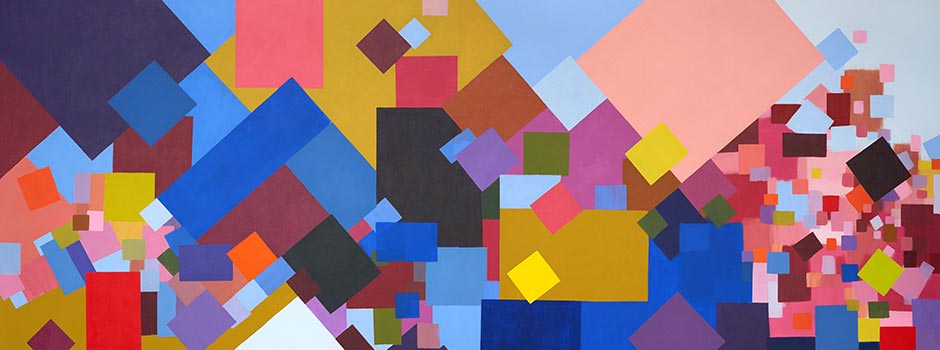
Alserkal Avenue, March 9 - June 17, 2017 Samia Halaby’s Concurrent Solo Shows at Ayyam Gallery Dubai
Feb 22, 2017 Exhibition

 Samia Halaby, Pale and Green,153 x 203 cm. Acrylic on linen canvas, 2015 / Courtesy of Ayyam Gallery Dubai
Samia Halaby, Pale and Green,153 x 203 cm. Acrylic on linen canvas, 2015 / Courtesy of Ayyam Gallery Dubai
Following a 2014 critically acclaimed retrospective at Ayyam Gallery Dubai (11 Alserkal Avenue) - which travelled to the Beirut Exhibition Center in 2015 - Halaby produced a new series of paintings with several directives in mind. 'Illuminated Space' highlights the artist’s latest experiments in abstraction, which unfolded over the course of two years.
The initial works of the series reflect her interest in biomorphic forms, abstract shapes inspired by the contours of living organisms. In paintings like 'Flowers' (2015), for example, Halaby focuses on the soft edges of plant life by incorporating shading, and arrives at varying degrees of luminosity with contrasting hues.
The suggestion of radiating light in Flowers developed into an exploration of what she describes as ‘the space of light.’ For Halaby, luminosity in her paintings emerges from, ‘The ambiances we see; be they dark night, evening light, or others—all are illuminated by types of light sources with their various colour relationships.’ The artist approached the concept of luminosity based on the ‘relative saturation’ that is found in the abstract paintings of Mark Rothko and Ad Reinhardt.
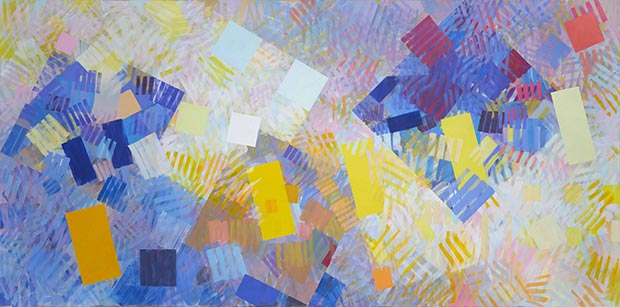 Samia Halaby 'Interwoven Through Depth' 207 x 420 cm. Acrylic on canvas 2016 / Courtesy of Ayyam Gallery Dubai
Samia Halaby 'Interwoven Through Depth' 207 x 420 cm. Acrylic on canvas 2016 / Courtesy of Ayyam Gallery Dubai
Halaby’s thoughts on color space are combined with an earlier focus on the soft and hard edges that are experienced in urban environments, which prompted her 2010 series 'Trees and the High Rising City'. Her recent canvases, such as 'Chinatown (2016), take her 'Lower Manhattan neighbourhood' as its point of reference once again, this time with a greater emphasis on the interplays of light (natural and artificial) that shape the city.
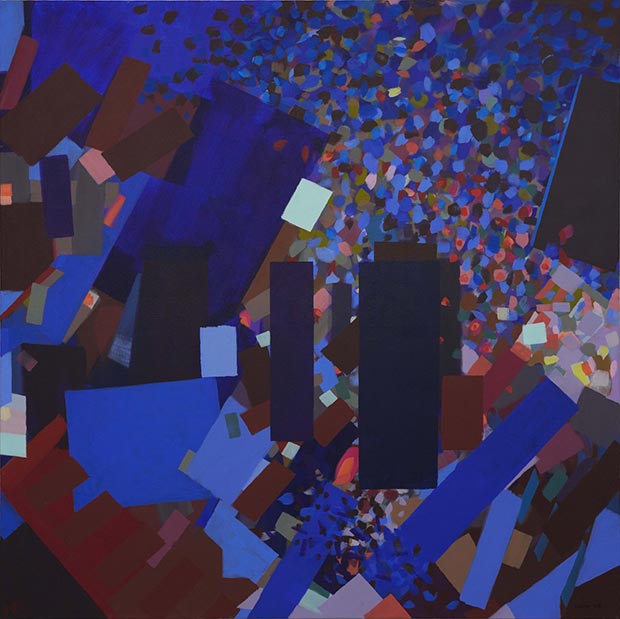 Samia Halaby, Chinatown, 153 x 153 cm. Acrylic on canvas 2016 / Courtesy of Ayyam Gallery Dubai
Samia Halaby, Chinatown, 153 x 153 cm. Acrylic on canvas 2016 / Courtesy of Ayyam Gallery Dubai
'Documentary Drawings of the Kafr Qasem Massacre' complements this look into Halaby’s artistic practice, albeit from a different vantage point. This smaller exhibition features a selection of drawings that depict the murders of 49 Palestinian civilians by Israeli border guards in 1956. More than a decade of research inform these works, as Halaby interviewed survivors of the massacre and the relatives of its victims in the Palestinian village, translated historical documents, including reportage of celebrated writer Emile Habibi, and gathered images from the period that she used as reference when composing her scenes. The resulting works employ a drawing style that is patterned after the realistic investigations of the body and nature that were popular during the Renaissance.
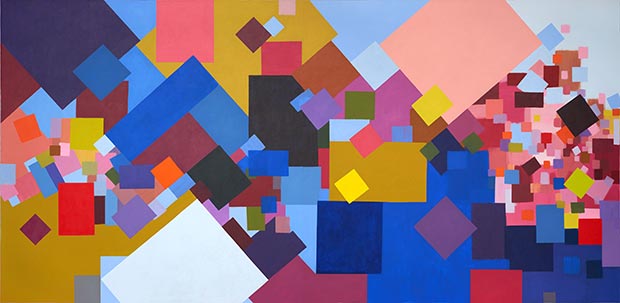 Samia Halaby, River and Cliff, 206 x 420 cm. Acrylic on canvas, 2016 / Courtesy of Ayyam Gallery Dubai
Samia Halaby, River and Cliff, 206 x 420 cm. Acrylic on canvas, 2016 / Courtesy of Ayyam Gallery Dubai
Born in Jerusalem in 1936, Samia Halaby is a leading abstract painter and an influential scholar of Palestinian art. Although based in the United States since 1951, Halaby is recognised as a pioneer of contemporary abstraction in the Arab world. Halaby began her career in the early 1960s, shortly after graduating from Indiana University with a Master of Fine Arts degree in Painting. While teaching at the Kansas City Art Institute in 1964, she travelled to the Eastern Mediterranean as part of a faculty research grant and studied the geometric abstraction of the region’s Islamic architecture, which has continuously factored into her work. During this time, Halaby launched into a series of experiments that would initiate a career-long investigation of the materialist principles of abstraction: how reality can be represented through form.
Also influenced by the abstract movements of the Russian avant-garde, Halaby works with the conviction that new approaches to painting can redirect ways of seeing and thinking not only within the realm of aesthetics but also as contributions to technological and social advancement. This underlying notion has led to additional experiments in drawing, printmaking, computerbased kinetic art, and free-from-the- stretcher painting. Halaby has been collected by international institutions since the 1970s, including the Solomon R. Guggenheim Museum of Art (New York and Abu Dhabi); Yale University Art Gallery; National Gallery of Art, Washington D.C.; Art Institute of Chicago; Cleveland Museum of Art; Institut du Monde Arabe; and the British Museum.
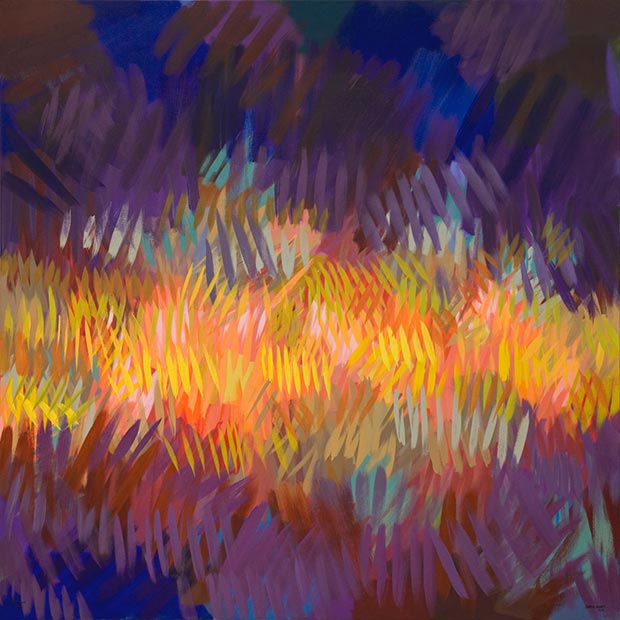 Samia Halaby, Volcano, 178 x 178 cm. Acrylic on linen canvas, 2015 / Courtesy of Ayyam Gallery Dubai
Samia Halaby, Volcano, 178 x 178 cm. Acrylic on linen canvas, 2015 / Courtesy of Ayyam Gallery Dubai
Selected solo shows for the artist include Beirut Exhibition Center (2015); Ayyam Gallery London (2015, 2013); Ayyam Gallery Al Quoz, Dubai (2014); Ayyam Gallery DIFC, Dubai (2011); and Ayyam Gallery Beirut (2010). She has participated in recent group shows at Darat Al Funun, Amman (2015); the National Academy of Arts, New York (2015); The Guggenheim Museum, Abu Dhabi (2014); Broadway 1602, New York (2014); and Institut du Monde Arabe, Paris (2009). In 2014 Booth-Clibborn Editions published the artist’s second monograph, Samia Halaby: Five Decades of Painting and Innovation.
From the 1960s until the late 1980s, Halaby taught at universities throughout the United States. She was the first full-time female associate professor at the Yale School of Art, a position she held for a decade. Her noteworthy contributions to American academia include a groundbreaking undergraduate studio art program that she introduced to art departments throughout the Midwest. Halaby’s writings on art have appeared in Leonardo: Journal of Arts, Sciences and Technology, Jerusalem Quarterly, and Arab Studies Quarterly, in addition to edited volumes, while her independently published survey Liberation Art of Palestine: Palestinian Paintings and Sculpture in the Second Half of the 20th Century (2002) is considered a seminal document of Palestinian art history. Halaby’s latest book is Drawing the Kafr Qasem Massacre (Amsterdam: Schilt Publishing, 2017).
Comments
Add a comment